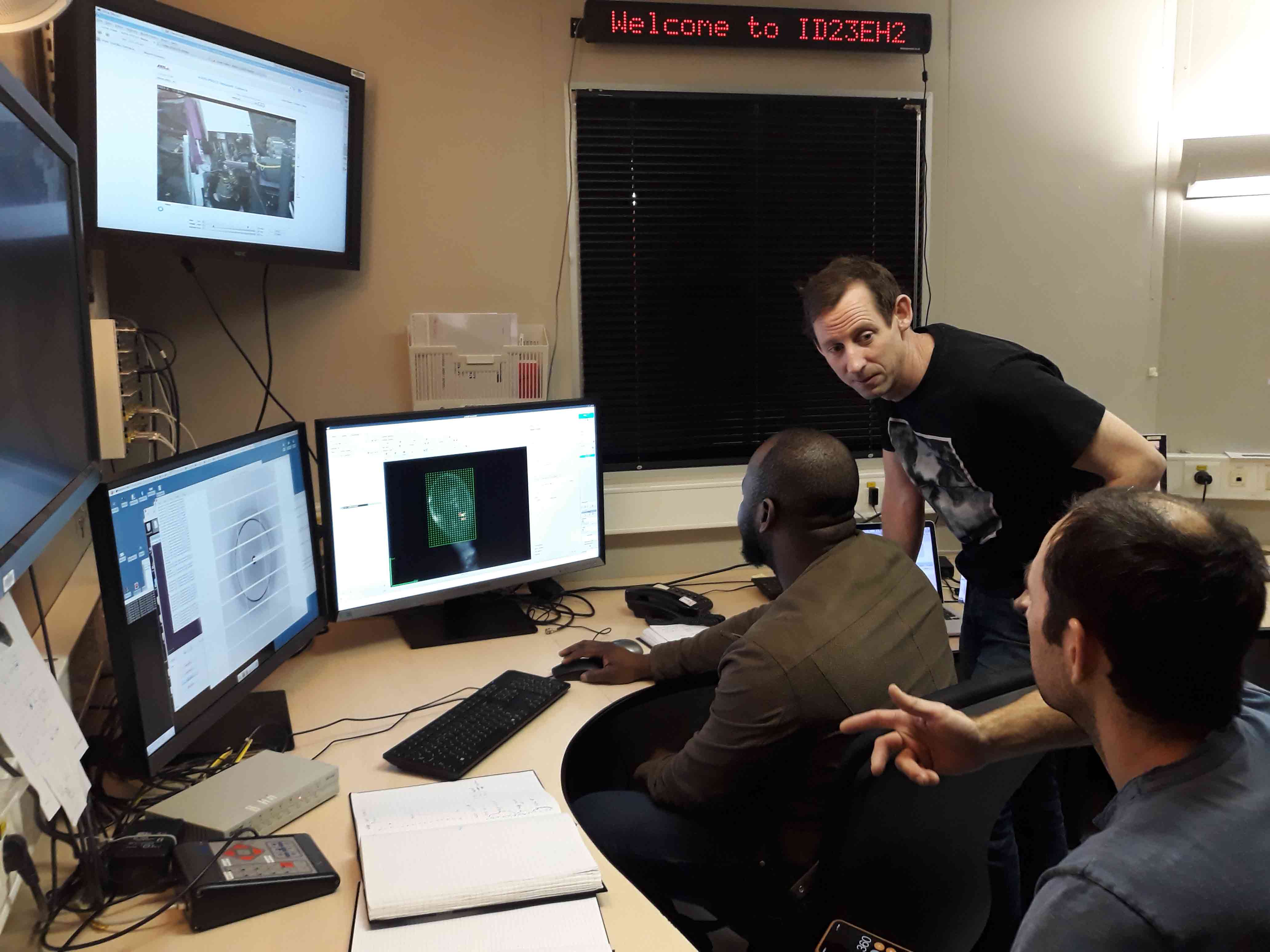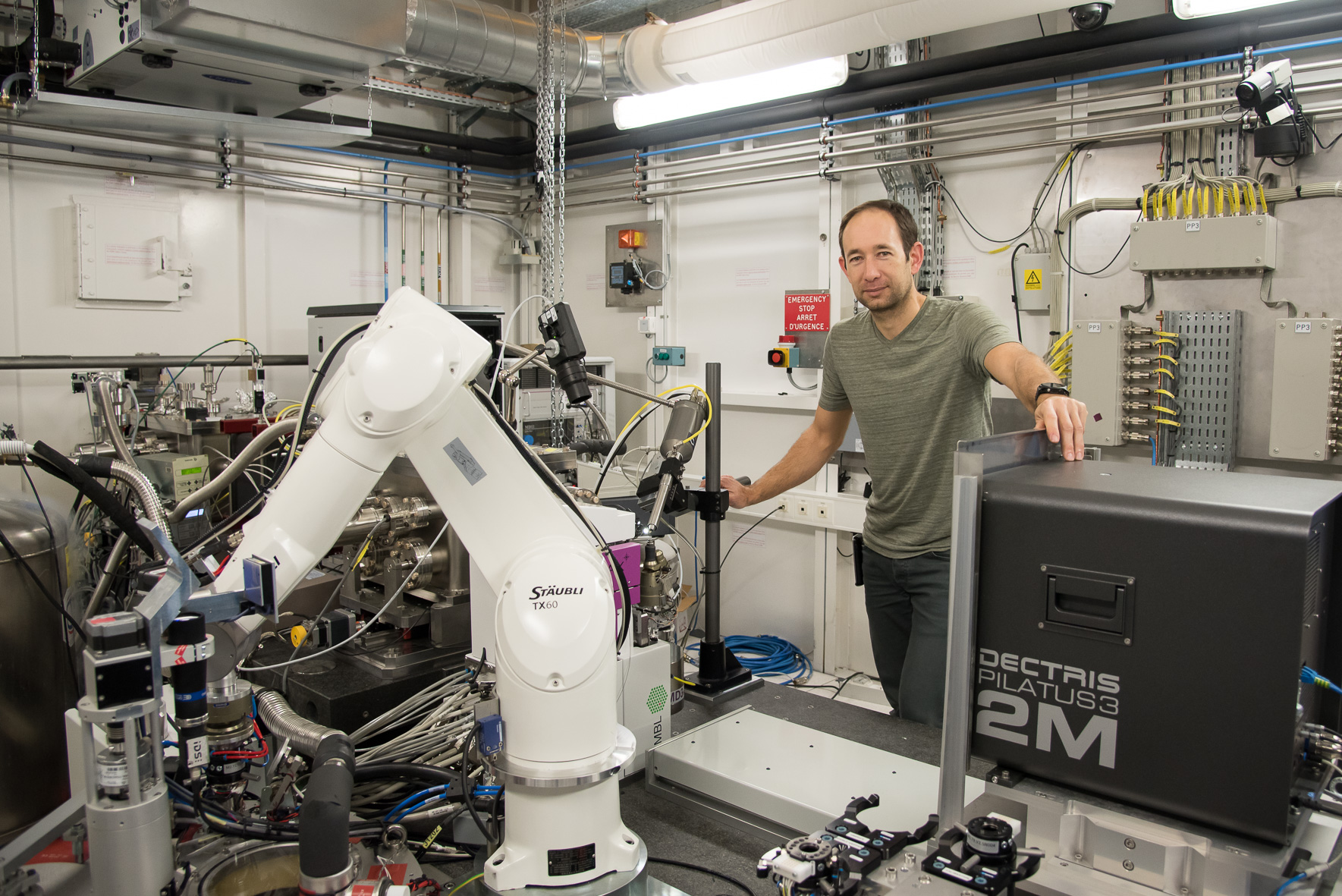- Home
- News
- General News
- ID23-EH2: Gearing...
ID23-EH2: Gearing up for serial crystallography
29-01-2018
ID23-EH2 is up and running, catering to small samples and serial crystallography experiments. Its small beam and unique diffractometer are the trademarks of this new MX beamline.
“This is amazing”, says David Drew, a user from Stockholm University, on the new ID23-EH2. “There is a perfect beamline to be screening LCP crystals. After 5 years working on this… it is amazing to be able to speed up finding the best spot to collect”, he adds. Drew and his team are on ID23-EH2. They are the first users since ID23-EH2 opened for business this month and have just started the experiment. He works with his team in transport proteins, which carry nutrients across membrane proteins and are important drug targets.
 |
|
The users in the control cabin of ID23-EH2. |
His samples are not easy to find in their sample holders, but with the new diffractometer on ID23-EH2, he can now rapidly scan a large area where he can find the best crystals in an automatic way. This is one of the aims of the new beamline: to focus on really tiny samples in a way that is made available to a wider public: “we don´t want users to have to depend on a micro-crystallography specialist 24/7 on the beamline. The idea is that they can do it themselves, and in a largely automated manner”, explains Max Nanao, beamline responsible.
With the smallest dedicated beam for MX at the ESRF at less than 10 µm in diameter, ID23-EH2 is in particular specialized to perform experiments with very small protein crystals and for serial crystallography. Serial Macromolecular Crystallography is an emerging technique that permits the assembly of complete datasets by combining single diffraction patterns or mini-oscillations collected from hundreds or thousands of microcrystals.
The beamline has been designed and built in collaboration with the EMBL.
MAX NANAOBEAMLINE RESPONSIBLE ID23-EH2 |
|
|
What does ID23-EH2 bring to the ESRF? We are a dedicated microfocus beamline, which means that we can study very small crystals and also diffractively map larger crystals. We have also focused significant resources in automation. With the upgrade, we now have a state of the art diffractometer (currently unique in the world) which can scan through samples very quickly. Serial crystallography will be the subject of the new EBS beamline in MX. How will your beamline help the conception of the new one? ID23-EH2 was designed to take full advantage of the EBS beam properties. Additionally, we look at ID23-EH2 as a kind of test bed to help us design and upgrade future MX beamlines at the ESRF, particularly for serial crystallographic experiments. How is automation on this beamline? When I started working on beamlines many years ago, individual data collections would take hours, whilst now you can do the same experiment in seconds or minutes. In this respect, automation is a 'life saver'. We have a database that tracks everything the users do during the experiment, so you don´t get lost in the sheer number of datasets possible during a single shift. Is MX today very different to MX in the past? Definitely. When I started, synchrotron beamtime was the most precious thing for crystallographers. Today, it is just as critical as it was when I started, but thankfully more accessible to users. It would have been hard to imagine the proliferation of synchrotron beamlines and how quickly we now do things. Samples have also gone down in size dramatically, robotic sample changing has increased the number of samples that can be evaluated during a shift and finally detector technology (such as the Pilatus and Eiger detectors available on all MX beamlines) have improved significantly, providing extremely high frame rates and low noise. |
|
Text by Montserrat Capellas Espuny. Pictures by Chantal Argoud and Montserrat Capellas Espuny.
Top image: Max Nanao with the users from the University of Stockholm (Sweden).




